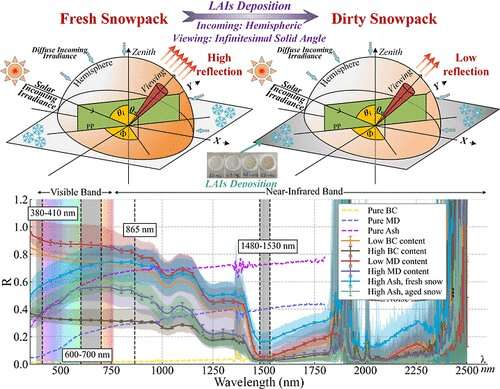This article has been reviewed according to Science X's editorial process and policies. Editors have highlighted the following attributes while ensuring the content's credibility:
fact-checked
peer-reviewed publication
trusted source
proofread
How different light-absorbing impurities in snow influence its reflectance characteristics

Light-absorbing impurities (LAIs) in snow influence spectral characteristics of snow, especially on its albedo, thus affecting the earth–air energy balance and indirectly leading to climate change.
However, there are few studies on the quantitative effects of different types of LAIs on spectral characteristics of snow, which limits the quantitative remote sensing inversion of snow contamination.
Using multi-angle spectroscopic measuring instruments, a joint team led by Prof. Hao Xiaohua from the Northwest Institute of Eco-Environment and Resources of the Chinese Academy of Sciences (CAS) collected data sets of hemispherical directional reflectance factor (HDRF) with different contents of black carbon (BC), mineral dust (MD), and ash in China's typical snow cover areas. The study was published in Environmental Science & Technology on June 7.
The researchers found that the perturbation of snow reflectance caused by LAIs was characterized by nonlinear deceleration, that is, the reduction in snow reflectance per unit ppm of LAIs decreased with increasing snow contamination.
"When BC is abundant, snow reflectivity may remain low without rapidly declining, and BC-induced snow darkening may reach saturation at its concentrations in the thousands of ppm," said Prof. Hao, corresponding author of the study.
Measurements suggested that extremely high LAIs concentration levels might increase its extinction range, with BC darkening snow over the entire measured range (350–2,500 nm), while MD and ash only affected up to 1,200 nm (350–1,200 nm).
Snow containing MD or ash showed abrupt spectral slope points around 600 and 700 nm, respectively. The deposition of a large number of MD or ash particles could increase snow reflectance beyond the wavelength of 1,400 nm, with an increase of 0.1 for MD and 0.2 for ash.
"Our study not only contributes to a comprehensive understanding of the effects of BC, MD and ash on the angular reflection characteristics of snow cover, but also provides a further understanding of LAIs, modeling albedo in dirty snow and estimating pollutant content," said Prof. Hao.
More information: Wenzheng Ji et al, Reflection of Solar Light from Surface Snow Loaded with Light-Absorbing Impurities: A Case Study of Black Carbon, Mineral Dust, and Ash, Environmental Science & Technology (2023). DOI: 10.1021/acs.est.3c01280
Journal information: Environmental Science & Technology
Provided by Chinese Academy of Sciences





















